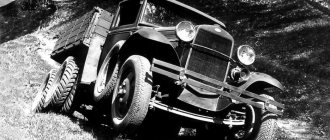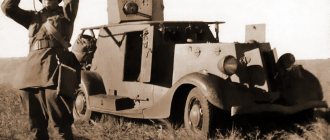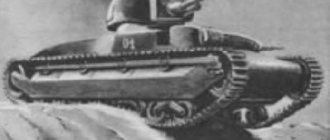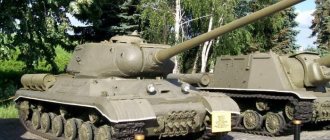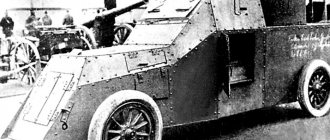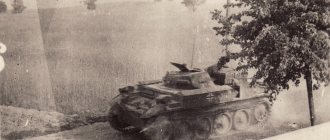BA-6
On the morning of January 12, 1943, what finally happened was what hungry, frozen Leningrad had been waiting for since the fall of 1941 - the troops of the Leningrad and Volkhov fronts began an offensive. The Soviet units united, breaking the blockade, on the 18th, near Shlisselburg. 19 BA-10 armored cars also took part in these battles. It was on the Leningrad Front, back in 1943, that there were many such machines, because they were repaired by the same Izhora plant that had previously produced them. Well, some of the armored cars went even further - to the west...
DUGGER ON WHEELS
The idea of an armored car is almost as old as the car itself. The first heyday of armored vehicles, as they were often called then, occurred during the First World War. Armored cars were made on the basis not only of trucks, but also of many passenger models - from the Ford T to the Rolls-Royce Silver Guest. In Russia, armored vehicles were built on the Russo-Balta chassis and imported ones. Well, almost immediately after the start of production of the first Soviet truck, the AMO-F15, on instructions from the Red Army artillery department, they developed the BA-27 with a 37 mm cannon and a 6.5 mm machine gun.
Domestic armored cars developed along with the automobile industry - slowly and difficultly. Of course, an armed vehicle requires a sufficiently powerful chassis and an appropriate engine. But our industry did neither one nor the other in the early 1930s. At first, we had to use a modified three-axle chassis of an imported Ford-Timken and a 40-horsepower Ford (aka Gorky after the launch of the plant on the Volga) engine.
BA-6
At the Izhora plant, having built a number of experimental and small-scale vehicles, in 1933 they began to produce the BA-3 with a 45-mm cannon in the turret of the T-26 tank. After modernization and installation on the domestic GAZ-AAA chassis, the vehicle received the designation BA-6. Its mass production began in 1936.
ACHIEVEMENT LIST
The fate of our armored cars of those years is amazing. Their heyday lasted only a decade, but what a decade! They managed to take part in four wars. The combat journey began in Spain, where 60 vehicles were delivered to the Republican army, including 37 BA-6s. On relatively good (compared to ours) roads they performed well. Sometimes they were even more useful than less fast tanks. Several vehicles went to the Francoists as trophies and were in their service for quite a long time. Moreover, the Soviet design was adapted to the Chevrolet three-axle chassis and such vehicles were produced in series.
In the summer of 1939, many armored vehicles went to Khalkhin Gol. They proved to be very effective not only in skirmishes with Japanese infantry and cavalry, but also against light tanks. True, many shortcomings immediately clearly appeared, which, however, were discussed before. Before attacking on rough terrain, the military recommended putting steel overroll tracks on the drive wheels, since an armored car stuck on the off-road became an excellent target, and the armor could not withstand the fire of a 13.2 mm Hotchkiss machine gun. Oh, and the generally inconvenient location of the crew members, especially the one who commanded the gun in the turret. The fire hazard of the car, in which the fighters were practically sitting in an embrace with a gas tank, was also high.
History of the LB-NATI armored car
The light armored vehicle LB-NATI (originally BA-8 NATI or BA-NATI) was developed in 1937-1939 and manufactured in a single copy by the Vyksa DRO plant in August 1939 (project manager - senior engineer N. Korotonoshko). The vehicle combined a number of design innovations and was the first domestic all-wheel drive armored vehicle. Although the thickness of the LB-NATI's armor did not exceed 10 mm, due to rational angles of inclination of the armor plates, the vehicle was well protected from enemy fire, had good speed (up to 80 km/h) and a range of almost 300 km.
Extensive tests carried out at the NIBT training ground revealed the superiority of the LB-NATI over the standard light armored car of the Red Army BA-20 in speed, maneuverability, protection and armament. However, quite a few shortcomings have emerged. The LB-NATI was refused to be accepted into service - at least until the acceptance committee's comments were eliminated. Unfortunately, the main ones were “irremovable contradictions”: overload of the hull and, as a consequence, rapid wear of the engine (unfortunately, a common problem with armored vehicles of the 1930s) and unreliability of the front axle (also a consequence of overload of the hull).
Drawing of an armored car LB-NATI
They did not begin to modify the LB-NATI - immediately after the end of the tests, all work on the project was curtailed. The only armored car built was used for some time as an experimental vehicle to study the design features of all-wheel drive vehicles. What happened to him subsequently, no information has been preserved.
BA-6
There is a gap between the engine compartment and the crew’s feet through which warm air passes into the cabin along with exhaust gases.
On the right is the machine gunner's position. There is a gap between the engine compartment and the crew’s feet through which warm air passes into the cabin along with exhaust gases. On the right is the machine gunner's position.
The Finnish War of 1940 added to the sad experience. All-wheel drive vehicles with rear dual-pitch tires often found themselves helpless on winter off-road conditions. The military wrote in reports that an engine of 90–100 hp was needed. instead of the 50-horsepower one, which was installed on the BA-10, there was a modernized BA-6. Many captured cars served in the Finnish army until the early 1960s, receiving what they so lacked - a powerful Ford “eight”. In our country, the BA-10, the most popular armored car in this class, was made until the fall of 1941, until the Germans came very close to Izhora.
THE MAIN MATTER OF LIFE
On June 22, 1941, a group of armored vehicles of the 5th Tank Division of the 3rd Mechanized Corps, skillfully camouflaged in the forest near the highway, under the command of Senior Lieutenant Surovtsev, held back a German column of light tanks and motorcycles for several hours. A small episode of a huge war - a few hours of “local battle”. It is unlikely that any of those fighters and those armored vehicles lived to see victory. But they managed to contribute to it.
Many vehicles broke down in the first months of the war; those that survived continued to fight both near Moscow and Leningrad. Even in 1944, several armored cars took part in the battles for Latvia - in particular, in the assault on Jelgava.
Design of the LB-NATI armored car
The chassis of the LB-NATI armored car was based on the components and assemblies of the GAZ-MM truck (wheels, steering mechanism, frame elements, gearbox), but was modified by NATI. The frame was shortened, the wheelbase was reduced to 2750 mm, the springs were replaced with longitudinal semi-elliptical ones, and the front and rear wheel suspension was equipped with hydraulic shock absorbers.
The car received a 6-cylinder engine from GAZ-61 with a power of 76 hp. (it was originally planned to supply a Dodge with a power of 72 hp), as well as a two-speed transfer case with a built-in center differential, providing three options for transmitting torque: to all wheels, only to the rear, only to the front.
LB-NATI armored vehicle undergoing testing
Both LB-NATI drive axles were driven, the rear wheels were equipped with double ramps. Both front and rear wheels had developed lugs. The wheel hubs had armor protection, the gas tank was protected, protected from bullets and shrapnel. The wheels of the car were filled with gummatic.
The body of the LB-NATI armored car is completely welded, the sheets have a rational angle of inclination.
To accommodate a crew of three people, as well as, if necessary, a passenger, the car body had doors; in addition, the designers provided an emergency hatch in its floor.
The turret is conical, unified with the turret of the T-40 light tank. The armament was 1x 12.7 mm DShK machine gun, 1x 7.62 mm DT machine gun.
Communication between the crew and the command was carried out using the 71-TK-1 radio station with a whip antenna.
BA-6
Under the armor plate is a Ganov 40-horsepower (later 50-horsepower) engine.
Under the armor plate is a Ganov 40-horsepower (later 50-horsepower) engine.
And in the last year of the war, cars were more often used as mobile checkpoints on front-line roads - today they would call it a checkpoint. The weather on the fields of the last battles of the Great Patriotic War was done exclusively by tanks, and they were supported by half-tracks and all-wheel drive American armored personnel carriers. It was these vehicles, much more advanced and practical, that became the reason for the complete oblivion of armored cars of the 1930s at the end of the war.
And how did they, our grandfathers, fight in this?! Getting into a low and narrow door and sitting on a small seat is already a problem! The puny 40-horsepower engine began to hum, the transmission howled strainedly, the BA-6, generously filling the cabin with exhaust gases (a kind of stove!), slowly drove off. I remember reading in military reports how tired the crews of armored cars were even on short marches. I believe! And if from the march - into battle? On the right, a machine gun is firing, a “magpie” rattles from above, shell casings are falling to the floor, enemy bullets are hitting the body. Meanwhile, the driver maneuvers, saving the crew and the car and seeing the world through a narrow embrasure. And they fought!
This car is like an ordinary unknown soldier at the beginning of the war, in a dirty gray overcoat, windings instead of boots, with a three-line rifle. But from the hard military labor of such nameless, unbrave privates and such imperfect, simple machines, our Victory took shape.
To understand its price, it’s useful to at least take a ride in this, by the way, completely original BA-6. The difficulties of modern life appear in a slightly different light after this...
BA-6
GUARD PRIVATE
The BA-6 armored car was produced in 1936–1938. The chassis is a modernized GAZ-AAA, the engine is 40-horsepower (later on the BA-6M with a modified frame and turret - 50-horsepower), 3-speed gearbox with range. Armor 8 mm, speed up to 42 km/h. 306 vehicles were built, some with radio stations. We also made a prototype for movement on rails. Until the fall of 1941, 3,331 units of the modernized BA-10 with a 50-horsepower engine were produced.
The editors thank the Central Museum of Armored Weapons and Equipment in Kubinka for providing the vehicle and assistance in organizing the shooting.
BA-6: ballad about a soldier
BA-9 Medium armored car
As is known, all Soviet armored vehicles made on the basis of a commercial chassis had several shortcomings, the most serious of which was considered to be poor cross-country ability. Its elimination could be solved in two ways - a radical reduction in weight, or the development of a specialized all-wheel drive chassis. The first option seemed simpler and more reliable, so in the fall of 1936 it received the highest priority.
The first prototype of the modernized armored car BA-6M
received a frame shortened by 600 mm and a driveshaft shortened by 200 mm, a more powerful GAZ M-1 engine (50 hp), reinforced front springs, additional stiffeners on the front axle, a different angle of installation of the steering column, as well as many smaller improvements.
The armored hull was made of rolled armor plates with a thickness of 6 to 10 mm, which was almost entirely borrowed from the serial BA-6. The only exception was the hood, which became more squat due to a decrease in the height of the radiator by 33 mm.
The BA-6M's armament consisted of a 45 mm 20K cannon and two 7.62 mm machine guns. The twin cannon-machine gun mount was mounted in a new conical turret with a wall angle of 10°.
The BA-6M prototype was built in an extremely short time and was tested at the end of autumn 1936. For the most part, the car lived up to expectations. Due to the measures taken, it was possible to increase the maximum speed, although cross-country ability still left much to be desired. Then a project for a lightweight version of the armored vehicle was submitted for consideration, distinguished by the installation of a 12.7-mm DK machine gun in the turret and one 7.62-mm DT machine gun in the frontal part of the hull. The reduction in firepower, in this case, was partially justified. The heavy machine gun made it possible to fight enemy light armored vehicles and infantry no less effectively, which was facilitated by its higher rate of fire. A more fundamental advantage of the DC was its high accuracy of fire. During comparative tests with the 20-mm ShVAK cannon, where shelling of armor plates 20 mm thick was carried out, at a distance of 500 meters the machine gun showed a 100% hit on the target. At a distance of 600 meters, this figure decreased to 33%, but for the Shpitalny gun everything looked even worse (42% and 10%, respectively). In addition, the elimination of the twin cannon-machine gun mount along with the shell ammunition rack allowed saving 500 kg of mass.
The new armored car was named BA-9
and was submitted for testing just a few weeks later. With a combat weight of 4300 kg, it was possible to obtain a slightly higher speed, while the driving characteristics remained almost at the same level. However, at the end of 1936, an order was received to begin serial production of the BA-9 and to produce at least 100 units the following year. However, the industry was unable to deliver so many DK machine guns. In January 1937, the assistant to the head of the ABTU, Sviridov, who was in charge of the supply of large-caliber machine guns, wrote in a letter to I. Khalepsky that as of January 9, the small arms department was ready to deliver only 50 DCs, while at least 250 were required.
Meanwhile, from March 3 to March 5, 1937, a specially appointed commission conducted repeated tests of the BA-9, during which it was revealed that the armament and working mechanisms were unsatisfactorily fastened and the vehicle needed to be sent for revision. Since large-scale production of the DK machine guns could not be established (the complexity of the design and the cost of the 12.7 mm machine gun were too high), further work on the BA-9 had to be stopped, although the second prototype was already ready for testing. The fate of the experimental machines remains unknown after this.
Sources: M. Kolomiets “Armor on wheels. History of the Soviet armored car 1925-1945", Moscow, Yauza\Eksmo. 2007
TACTICAL AND TECHNICAL DATA OF THE MEDIUM ARMORED CAR BA-3 model 1934
| COMBAT WEIGHT | 4500 kg |
| CREW, people | 3 |
| DIMENSIONS | |
| Length, mm | 4760 |
| Width, mm | 1970 |
| Height, mm | 2090 |
| Ground clearance, mm | 240 |
| WEAPONS | one 12.7 mm DK machine gun and one 7.62 mm DT machine gun in the turret, one DT machine gun in the hull |
| AMMUNITION | 1000 rounds of 12.7 mm caliber 1512 rounds of 7.62 mm caliber |
| AIMING DEVICES | telescopic sight TOP-1 optical sight (for course machine gun) |
| RESERVATION | hull forehead - 10 mm hull side - 8 mm engine compartment forehead - 10 mm engine compartment side - 6-8 mm turret forehead - 10 mm turret side - 8 mm stern - 8 mm roof - 6 mm bottom - 3 mm |
| ENGINE | GAZ-M1, carburetor, liquid cooling, 60 hp. |
| TRANSMISSION | mechanical type with range multiplier |
| CHASSIS | wheel formula 6x4: single front wheels, dual rear wheels, bullet-resistant pneumatic tires, leaf spring suspension |
| SPEED | 55 km/h on the highway |
| POWER RESERVE | 230 km on the highway 180 km on the country road |
| OBSTACLES TO OVERCOME | |
| Rise, deg. | 20° |
| Wall height, m | ? |
| Fording depth, m | 0,60 |
| Ditch width, m | ? |
| MEANS OF COMMUNICATION | ? |
